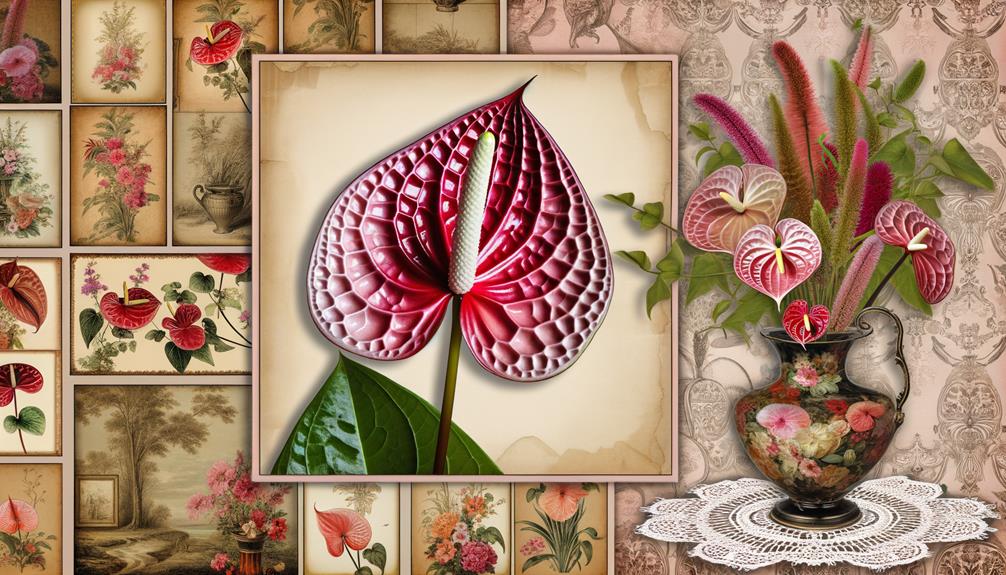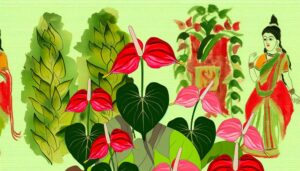Decoding the Anthurium: Understanding Its Victorian Era Meaning
In Victorian times, the anthurium wasn't just an exotic bloom; it carried significant meaning in the language of flowers, or floriography. Its heart-shaped leaves and vibrant colors symbolized hospitality, happiness, and romantic feelings.
Imported from Central and South American rainforests, anthuriums became prized for their unique appearance and association with wealth and sophistication. These flowers often featured as centerpieces in floral arrangements, reflecting the era's keen interest in both botanical exploration and intricate, coded communication.
To uncover the deeper nuances of how Victorians used anthuriums to convey complex emotions, explore the rich tapestry of their symbolic practices further.

Key Takeaways
- Anthuriums symbolized hospitality and happiness in Victorian floriography.
- Their heart-shaped leaves and bright colors conveyed joy, prosperity, and romantic feelings.
- Originating from Central and South American rainforests, anthuriums were exotic and highly prized.
- They represented wealth, sophistication, and advanced horticultural knowledge.
- Anthuriums often served as striking centerpieces in Victorian floral arrangements, reflecting botanical exploration.
The Language of Flowers
The Victorian era's fascination with the language of flowers, also known as floriography, provided a nuanced means of communication where each bloom conveyed specific emotions and messages. During this period, people employed flowers to express sentiments that words sometimes couldn't. This coded language allowed for the exchange of feelings in a society that valued propriety and subtlety.
For example, a red rose symbolized deep romantic love, while a white lily indicated purity. Understanding this floral lexicon required keen knowledge and attention to detail. You'll find that each flower, color, and even arrangement had its own unique significance.
This complex system enabled Victorians to communicate covertly, adding layers of meaning to their social interactions. The language of flowers was both intricate and highly symbolic.
Anthurium's Symbolic Significance
Anthurium, often recognized for its striking and exotic appearance, carried a distinct set of meanings in Victorian floriography. You'd find that this vibrant flower symbolized hospitality and happiness due to its heart-shaped leaves and bright, welcoming colors. During the Victorian era, it was commonly used to convey these sentiments in floral arrangements. Let's explore the specific symbolism:
| Symbolism | Meaning |
|---|---|
| Hospitality | Warm welcome |
| Happiness | Joy and positivity |
| Abundance | Prosperity |
| Beauty | Aesthetic appeal |
| Love | Romantic feelings |
Understanding the anthurium's symbolic significance can provide you with deeper insights into how Victorians communicated complex emotions through flowers. It adds a nuanced layer to appreciating these beautiful blooms beyond their visual appeal.
Historical Context of Anthuriums
During the Victorian era, anthuriums gained popularity as exotic imports that added a touch of the tropics to English gardens and conservatories. Originating from the lush rainforests of Central and South America, anthuriums were prized for their striking, heart-shaped spathes and glossy foliage.
Their introduction coincided with a period of intense botanical exploration and colonial expansion, which brought many new plant species to Europe. You'll find that the Victorians were fascinated by the exotic and unusual, often associating these plants with wealth and sophistication.
The ability to cultivate such rare specimens also demonstrated advanced horticultural knowledge and technology. This historical context underscores the cultural and scientific significance of anthuriums during the era, positioning them as symbols of both status and curiosity.
Victorian Floral Arrangements
In Victorian floral arrangements, incorporating anthuriums signaled an appreciation for exotic beauty and a mastery of horticultural trends.
You'd notice that these arrangements often featured a mix of native and imported flora, reflecting the era's fascination with botanical exploration.
Anthuriums, with their striking appearance, contrasted sharply with more traditional flowers, making them a centerpiece in many compositions.
Hidden Messages and Meanings
Victorian society imbued flowers with a complex system of hidden messages and meanings, transforming gifting and receiving them into an intricate form of communication. You'd find that each flower carried a specific sentiment, allowing people to convey emotions and intentions without words.
For instance, the anthurium, with its striking heart-shaped spathe, symbolized hospitality and happiness. It could express warmth and welcome, making it a thoughtful gift for guests. However, you also needed to take into account the color and arrangement, as these factors could alter the intended message.
This floral language required careful attention to detail, ensuring that your gestures were understood correctly. By mastering these codes, you could navigate the social intricacies of the era with finesse and subtlety.
Conclusion
In decoding the anthurium, you've opened a secret garden of Victorian symbolism, akin to deciphering a Shakespearean sonnet. Understanding its role in floral arrangements and hidden messages offers a deeper appreciation of historical nuances.
Much like a well-placed metaphor, the anthurium spoke volumes without uttering a word, embodying complex emotions in a single bloom.
So next time you see an anthurium, think beyond its beauty—consider the rich tapestry of meaning it carries from the Victorian era.






